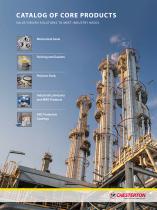
- Materials - Tools - Components
- Standard Mechanical Component
- Lipped seal
- A.W. Chesterton Company
- Products
- Catalogs
- News & Trends
- Exhibitions
Lip seal PLSpolymerfor pumpshousing

Add to favorites
Compare this product
Characteristics
- Type
- lip
- Material
- polymer
- Application
- for pumps, housing, gearbox, dust, shaft, handling, bearing
- Fluid
- water
- Other characteristics
- labyrinth, custom
- Temperature limit
Max.: 93 °C
(199 °F)Min.: -40 °C
(-40 °F)- Diameter
Max.: 501 mm
(19.724 in)Min.: 25 mm
(0.984 in)
Description
Unitized, Non-Contacting Seal for Bearing Protection
Bronze Award Winner: Plant Engineering's 2016 Product of the Year Award in the Fluid Handling category
Made from Chesterton’s proprietary polymer material technology, the Chesterton, patent-pending Polymer Labyrinth Seal (PLS) is a non-contact bearing seal designed to provide protection for pumps, motors, gearboxes, and other rotating equipment in splash applications. The unique design eliminates fretting caused by conventional lip seals, and helps increase bearing and gearbox life by extending the mean time between equipment repairs.
The design also incorporates a built-in valve, activated by shaft rotation, which engages during shutdown periods to create a positive seal during idle time—blocking the ingress of external contaminants from entering the housing.
Available with same-day shipment to minimize downtime and associated costs.
Features & Benefits
High-performance, non-contact design eliminates fretting caused by lip seals
Keeps lubrication in and seals out external contamination
Unitized design and durable, non-sparking material provide easy, reliable installation
Available in a variety of configurations to meet plant-wide equipment needs
Same-day shipment availability, minimizing downtime and associated costs
Standard sizes available for popular equipment; custom sizes available upon request
IP56 (third party certification) designed to be resistant to dust and water
Catalogs
Related Searches
- Polymer seal
- Mechanical seal
- Lip seal
- Circular gasket
- Pump mechanical seal
- Metal mechanical seal
- Metal seal
- PTFE gasket
- NBR seal
- Spring mechanical seal
- Flat gasket
- Cartridge mechanical seal
- Shafts seal
- Balanced mechanical seal
- Braided PTFE packing
- Braided graphite packing
- Mechanical seal for the chemical industry
- Dynamic seal
- Elastomer gasket
- Braided pump packing
*Prices are pre-tax. They exclude delivery charges and customs duties and do not include additional charges for installation or activation options. Prices are indicative only and may vary by country, with changes to the cost of raw materials and exchange rates.




